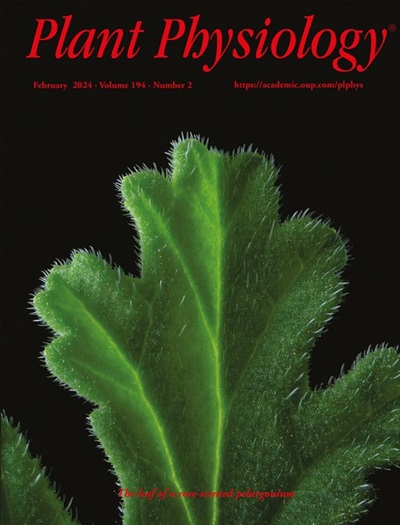dn-OPDA conjugation with amino acids inhibits its phytohormone bioactivity in Marchantia polymorpha
IF 6.5
1区 生物学
Q1 PLANT SCIENCES
引用次数: 0
Abstract
Jasmonates are important phytohormones that regulate plant tolerance to biotic and abiotic stresses, and developmental processes. Distinct jasmonates in different plant lineages activate a conserved signalling pathway that mediates these responses: dinor-12-oxo-phytodienoic acid (dn-OPDA) isomers in bryophytes and lycophytes, and JA-Ile in most vascular plants. In many cases, the final responses triggered by these phytohormones depend on the accumulation of specialized metabolites. To identify compounds regulated by the dn-OPDA pathway in the liverwort Marchantia polymorpha, untargeted metabolomic analyses were carried out in response to wounding, a stress that activates the dn-OPDA pathway. A previously unreported group of molecules was identified from these analyses: dn-OPDA-amino acid conjugates (dn-OPDA-aas). Their accumulation after wounding and herbivory was confirmed by targeted metabolic profiling in Marchantia and in all species in which we previously detected dn-iso-OPDA. Mutants in GRETCHEN-HAGEN 3A (MpGH3A) failed to accumulate dn-OPDA-aa conjugates and showed a constitutive activation of the OPDA pathway and increased resistance to herbivory. Our results show that dn-iso-OPDA bioactivity is reduced by amino acid conjugation. Therefore, jasmonate conjugation in land plants plays dichotomous roles: jasmonic acid (JA) conjugation with isoleucine (Ile) produces the bioactive JA-Ile in tracheophytes, whereas conjugation of dn-iso-OPDA with different amino acids deactivates the phytohormone in bryophytes and lycophytes.dn-OPDA 与氨基酸共轭可抑制其在马钱子中的植物激素生物活性
茉莉酸盐是重要的植物激素,可调节植物对生物和非生物胁迫的耐受性以及发育过程。在不同的植物品系中,不同的茉莉酸盐会激活介导这些反应的保守信号通路:裸子植物和狼尾草中的二醛酸-12-氧代-2-磷酸(dn-OPDA)异构体,以及大多数维管束植物中的 JA-Ile。在许多情况下,这些植物激素引发的最终反应取决于特殊代谢物的积累。为了确定肝草(Marchantia polymorpha)中受 dn-OPDA 通路调节的化合物,研究人员针对伤口(一种能激活 dn-OPDA 通路的胁迫)进行了非靶向代谢组分析。这些分析发现了一组以前未报道过的分子:dn-OPDA-氨基酸共轭物(dn-OPDA-aas)。通过对 Marchantia 和我们之前检测到 dn-iso-OPDA 的所有物种进行定向代谢分析,证实了它们在受伤和食草后的积累。GRETCHEN-HAGEN 3A(MpGH3A)的突变体不能积累 dn-OPDA-aa 共轭物,并表现出 OPDA 通路的组成性激活和对食草动物的更强抵抗力。我们的研究结果表明,氨基酸共轭会降低 dn-iso-OPDA 的生物活性。因此,茉莉酸盐在陆生植物中的共轭作用具有两重性:茉莉酸(JA)与异亮氨酸(Ile)共轭可在气管植物中产生具有生物活性的 JA-Ile,而 dn-iso-OPDA 与不同氨基酸共轭则会使毛叶植物和狼尾草植物中的植物激素失活。
本文章由计算机程序翻译,如有差异,请以英文原文为准。
求助全文
约1分钟内获得全文
求助全文
来源期刊

Plant Physiology
生物-植物科学
CiteScore
12.20
自引率
5.40%
发文量
535
审稿时长
2.3 months
期刊介绍:
Plant Physiology® is a distinguished and highly respected journal with a rich history dating back to its establishment in 1926. It stands as a leading international publication in the field of plant biology, covering a comprehensive range of topics from the molecular and structural aspects of plant life to systems biology and ecophysiology. Recognized as the most highly cited journal in plant sciences, Plant Physiology® is a testament to its commitment to excellence and the dissemination of groundbreaking research.
As the official publication of the American Society of Plant Biologists, Plant Physiology® upholds rigorous peer-review standards, ensuring that the scientific community receives the highest quality research. The journal releases 12 issues annually, providing a steady stream of new findings and insights to its readership.
 求助内容:
求助内容: 应助结果提醒方式:
应助结果提醒方式:


